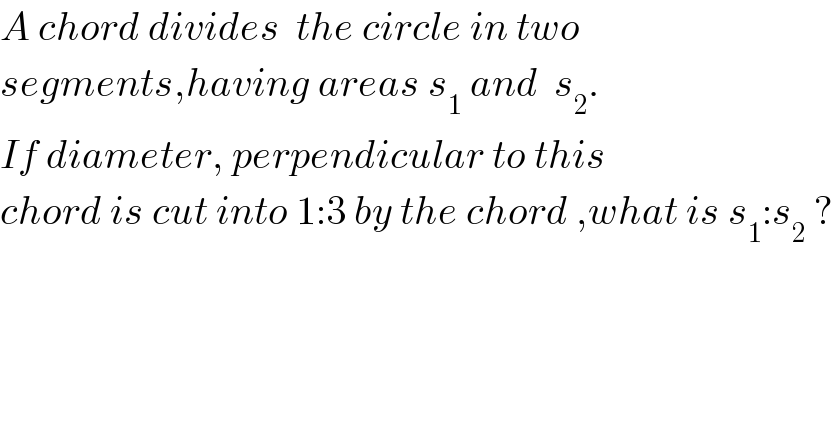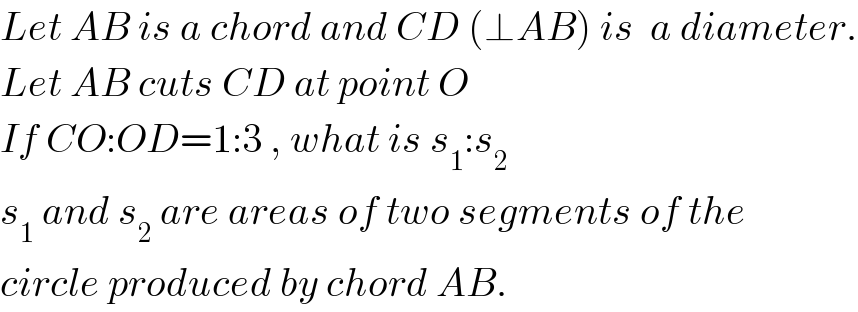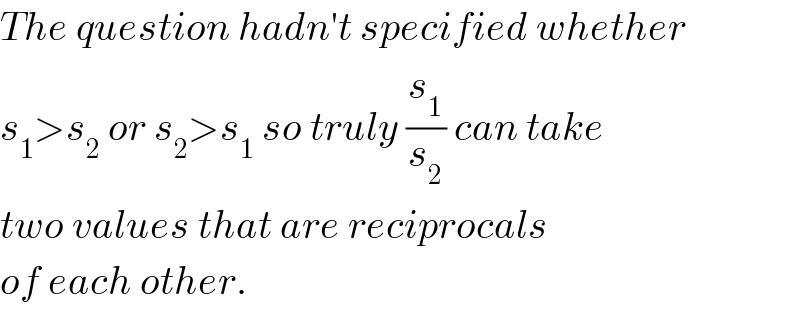
Question Number 3808 by Rasheed Soomro last updated on 21/Dec/15

$${A}\:{chord}\:{divides}\:\:{the}\:{circle}\:{in}\:{two} \\ $$$${segments},{having}\:{areas}\:{s}_{\mathrm{1}} \:{and}\:\:{s}_{\mathrm{2}} . \\ $$$${If}\:{diameter},\:{perpendicular}\:{to}\:{this} \\ $$$${chord}\:{is}\:{cut}\:{into}\:\mathrm{1}:\mathrm{3}\:{by}\:{the}\:{chord}\:,{what}\:{is}\:{s}_{\mathrm{1}} :{s}_{\mathrm{2}} \:? \\ $$$$ \\ $$
Commented by Rasheed Soomro last updated on 21/Dec/15

$${Let}\:{AB}\:{is}\:{a}\:{chord}\:{and}\:{CD}\:\left(\bot{AB}\right)\:{is}\:\:{a}\:{diameter}. \\ $$$${Let}\:{AB}\:{cuts}\:{CD}\:{at}\:{point}\:{O} \\ $$$${If}\:{CO}:{OD}=\mathrm{1}:\mathrm{3}\:,\:{what}\:{is}\:{s}_{\mathrm{1}} :{s}_{\mathrm{2}} \\ $$$${s}_{\mathrm{1}} \:{and}\:{s}_{\mathrm{2}} \:{are}\:{areas}\:{of}\:{two}\:{segments}\:{of}\:{the} \\ $$$${circle}\:{produced}\:{by}\:{chord}\:{AB}. \\ $$
Answered by Yozzii last updated on 21/Dec/15

$$\left({Integral}\:{Calculus}\:{can}\:{alternatively}\right. \\ $$$$\left.{be}\:{used}\:{to}\:{find}\:{the}\:{value}\:{of}\:\frac{{s}_{\mathrm{1}} }{{s}_{\mathrm{2}} }.\right) \\ $$$${Draw}\:{a}\:{circle}\:{with}\:{diameter}\:{length}\:{d}\:{and}\: \\ $$$${centre}\:{Q}.\:{A}\:{diameter}\:{of}\:{the}\:{circle}\:{normally} \\ $$$${cuts}\:{a}\:{chord}\:{AB}\:{on}\:{the}\:{circle}\:{such}\:{that} \\ $$$${d}\:{is}\:{partitioned}\:{in}\:{the}\:{ratio}\:\mathrm{1}:\mathrm{3}.\:{Let} \\ $$$${LF}\:\:{be}\:{such}\:{a}\:{diameter}\:{and}\:{D}\:{be}\:{the}\: \\ $$$${point}\:{of}\:{intersection}\:{of}\:{the}\:{chord}\:{AB} \\ $$$${and}\:{diameter}\:{LF}.\:{We}\:{thus}\:{have}\: \\ $$$$\mid{LD}\mid=\mathrm{3}{a}\:{and}\:\mid{DF}\mid={a}\:\left({a}>\mathrm{0}\right)\:{so}\:{that}\:{DF}:{LD}=\mathrm{1}:\mathrm{3}. \\ $$$${Therefore},\:{d}=\mathrm{3}{a}+{a}=\mathrm{4}{a}\Rightarrow\:{radius}\:{r}=\mathrm{2}{a}. \\ $$$${Complete}\:{the}\:{isosceles}\:{triangle}\:\bigtriangleup{AQB} \\ $$$${and}\:{let}\:\angle{AQB}=\theta.\:{The}\:{area}\:{A}_{\mathrm{1}\:} {of}\:{the}\:{sector}\:{AB} \\ $$$${of}\:{the}\:{circle}\:{is}\:{then} \\ $$$$\:{A}_{\mathrm{1}} =\frac{\mathrm{1}}{\mathrm{2}}{r}^{\mathrm{2}} \theta=\frac{\mathrm{1}}{\mathrm{2}}×\mathrm{4}{a}^{\mathrm{2}} \theta=\mathrm{2}{a}^{\mathrm{2}} \theta. \\ $$$${The}\:{area}\:{of}\:\bigtriangleup{AQB},{denoted}\:{by}\:{A}_{\mathrm{2}} ,\:{is}\:{given}\:{by} \\ $$$${A}_{\mathrm{2}} =\frac{\mathrm{1}}{\mathrm{2}}\mathrm{2}{a}×\mathrm{2}{a}×{sin}\theta=\mathrm{2}{a}^{\mathrm{2}} {sin}\theta. \\ $$$${Now},\:{let}\:{s}_{\mathrm{1}} \:{be}\:{the}\:{area}\:{between}\:{the}\:{chord} \\ $$$${AB}\:{and}\:{the}\:{arc}\:{AB}.\: \\ $$$$\Rightarrow{s}_{\mathrm{1}} ={A}_{\mathrm{1}} −{A}_{\mathrm{2}} =\mathrm{2}{a}^{\mathrm{2}} \left(\theta−{sin}\theta\right) \\ $$$${Hence},\:{the}\:{area}\:{of}\:{the}\:{other}\:{segment} \\ $$$${of}\:{the}\:{circle}\:{is}\:{s}_{\mathrm{2}} =\pi{r}^{\mathrm{2}} −{s}_{\mathrm{1}} . \\ $$$${s}_{\mathrm{2}} =\mathrm{4}\pi{a}^{\mathrm{2}} −\mathrm{2}{a}^{\mathrm{2}} \left(\theta−{sin}\theta\right) \\ $$$${s}_{\mathrm{2}} =\mathrm{2}{a}^{\mathrm{2}} \left(\mathrm{2}\pi+{sin}\theta−\theta\right) \\ $$$${Therefore},\:\frac{{s}_{\mathrm{1}} }{{s}_{\mathrm{2}} }=\frac{\theta−{sin}\theta}{\mathrm{2}\pi+{sin}\theta−\theta}. \\ $$$${Returning}\:{to}\:\bigtriangleup{AQB},\:{we}\:{can}\:{yield} \\ $$$${a}\:{right}−{angled}\:{triangle}\:\bigtriangleup{AQD} \\ $$$${with}\:\angle{AQD}=\frac{\mathrm{1}}{\mathrm{2}}\angle{AQB}=\frac{\theta}{\mathrm{2}} \\ $$$${and}\:\angle{QDA}=\frac{\pi}{\mathrm{2}}. \\ $$$${We}\:{then}\:{have}\:{cos}\frac{\theta}{\mathrm{2}}=\frac{{QD}}{{AQ}}=\frac{{a}}{\mathrm{2}{a}}=\frac{\mathrm{1}}{\mathrm{2}} \\ $$$$\Rightarrow\frac{\theta}{\mathrm{2}}=\frac{\pi}{\mathrm{3}}\Rightarrow\theta=\frac{\mathrm{2}\pi}{\mathrm{3}}. \\ $$$$\therefore\:\frac{{s}_{\mathrm{1}} }{{s}_{\mathrm{2}} }=\frac{\frac{\mathrm{2}\pi}{\mathrm{3}}−{sin}\frac{\mathrm{2}\pi}{\mathrm{3}}}{\mathrm{2}\pi+{sin}\frac{\mathrm{2}\pi}{\mathrm{3}}−\frac{\mathrm{2}\pi}{\mathrm{3}}}=\frac{\frac{\mathrm{2}\pi}{\mathrm{3}}−\frac{\sqrt{\mathrm{3}}}{\mathrm{2}}}{\mathrm{2}\pi+\frac{\sqrt{\mathrm{3}}}{\mathrm{2}}−\frac{\mathrm{2}\pi}{\mathrm{3}}} \\ $$$$\frac{{s}_{\mathrm{1}} }{{s}_{\mathrm{2}} }=\frac{\mathrm{4}\pi−\mathrm{3}\sqrt{\mathrm{3}}}{\mathrm{8}\pi+\mathrm{3}\sqrt{\mathrm{3}}} \\ $$$$ \\ $$$$ \\ $$$$ \\ $$$$ \\ $$$$ \\ $$$$ \\ $$
Commented by Rasheed Soomro last updated on 21/Dec/15

$$''....{A}\:{diameter}\:{of}\:{the}\:{circle}\:{normally} \\ $$$${cuts}\:{a}\:{chord}\:{AB}\:\underset{−} {{on}\:{the}\:{circle}}\:{such}\:{that} \\ $$$${d}\:{is}\:{partitioned}\:{in}\:{the}\:{ratio}\:\mathrm{1}:\mathrm{3}....'' \\ $$$${What}\:{do}\:{you}\:{mean}\:{by}\:{this}? \\ $$
Commented by Yozzii last updated on 21/Dec/15

$${normally}\Rightarrow{perpendicularly}\:\left({in}\:{math}\:{terms}\right) \\ $$
Commented by Yozzii last updated on 21/Dec/15

$$ \\ $$$${The}\:{diameter}\:{cuts}\:{the}\:{chord}\:{at}\:\mathrm{90}° \\ $$$${with}\:{the}\:{chord}\:{divinding}\:{the}\:{length}\:{of} \\ $$$${the}\:{diameter}\:{in}\:{the}\:{ratio}\:\mathrm{1}:\mathrm{3}. \\ $$
Commented by Yozzii last updated on 21/Dec/15

$${The}\:{question}\:{hadn}'{t}\:{specified}\:{whether} \\ $$$${s}_{\mathrm{1}} >{s}_{\mathrm{2}} \:{or}\:{s}_{\mathrm{2}} >{s}_{\mathrm{1}} \:{so}\:{truly}\:\frac{{s}_{\mathrm{1}} }{{s}_{\mathrm{2}} }\:{can}\:{take} \\ $$$${two}\:{values}\:{that}\:{are}\:{reciprocals} \\ $$$${of}\:{each}\:{other}. \\ $$
Commented by Rasheed Soomro last updated on 22/Dec/15

$${Thanks}!\:{Misunderstanding}\:{in}\:{understanding} \\ $$$${language}.{I}\:{got}\:'\boldsymbol{{normally}}'\:\:{in}\:{normal}\:{language}, \\ $$$${not}\:{as}\:{mathematical}\:{term}. \\ $$
Commented by Rasheed Soomro last updated on 21/Dec/15

$$\mathcal{G}^{\mathcal{O}^{\:\:{V}} \mathcal{O}} \mathcal{D}\:\mathcal{A}{pproach}! \\ $$
Answered by Yozzii last updated on 21/Dec/15

$$\left({Integral}\:{calculus}\:{method}\:{based}\:{on}\right. \\ $$$$\left.{initial}\:{information}\:{from}\:{first}\:{answer}.\right) \\ $$$$ \\ $$$${Define}\:{a}\:{circle}\:{C}\:{with}\:{equation}\: \\ $$$${x}^{\mathrm{2}} +{y}^{\mathrm{2}} =\mathrm{4}{a}^{\mathrm{2}} ,\:{a}>\mathrm{0}. \\ $$$${For}\:{C}\:,{let}\:{s}_{\mathrm{1}} \:{be}\:{the}\:{area}\:{between}\:{the}\: \\ $$$${chord}\:{AB}\:{and}\:{the}\:{arc}\:{AB}.\:{We}\:{can}\:{let} \\ $$$${the}\:{diameter}\:{normal}\:{to}\:{AB}\:{be}\:{concurrent} \\ $$$${with}\:{the}\:{x}−{axis}. \\ $$$$\therefore\:{s}_{\mathrm{1}} =\int_{{a}} ^{\mathrm{2}{a}} {ydx} \\ $$$${s}_{\mathrm{1}} =\int_{{a}} ^{\mathrm{2}{a}} \sqrt{\mathrm{4}{a}^{\mathrm{2}} −{x}^{\mathrm{2}} }{dx} \\ $$$${Let}\:{x}=\mathrm{2}{asin}\theta\Rightarrow{dx}=\mathrm{2}{acos}\theta{d}\theta \\ $$$${and}\:\sqrt{\mathrm{4}{a}^{\mathrm{2}} −{x}^{\mathrm{2}} }=\mathrm{2}{acos}\theta. \\ $$$${At}\:{x}={a}\Rightarrow{sin}\theta=\mathrm{1}/\mathrm{2}\Rightarrow\theta=\frac{\pi}{\mathrm{6}}. \\ $$$${At}\:{x}=\mathrm{2}{a}\Rightarrow{sin}\theta=\mathrm{1}\Rightarrow\theta=\pi/\mathrm{2}. \\ $$$$\therefore{s}_{\mathrm{1}} =\mathrm{2}\int_{\pi/\mathrm{6}} ^{\pi/\mathrm{2}} \mathrm{4}{a}^{\mathrm{2}} {cos}^{\mathrm{2}} \theta{d}\theta \\ $$$${s}_{\mathrm{1}} =\mathrm{4}{a}^{\mathrm{2}} \int_{\pi/\mathrm{6}} ^{\pi/\mathrm{2}} \left(\mathrm{1}+{cos}\mathrm{2}\theta\right){d}\theta \\ $$$${s}_{\mathrm{1}} =\mathrm{4}{a}^{\mathrm{2}} \left(\theta+\frac{\mathrm{1}}{\mathrm{2}}{sin}\mathrm{2}\theta\right)\mid_{\pi/\mathrm{6}} ^{\pi/\mathrm{2}} \\ $$$${s}_{\mathrm{1}} =\mathrm{4}{a}^{\mathrm{2}} \left(\frac{\pi}{\mathrm{2}}−\frac{\pi}{\mathrm{6}}+\frac{\mathrm{1}}{\mathrm{2}}{sin}\pi−\frac{\mathrm{1}}{\mathrm{2}}{sin}\frac{\pi}{\mathrm{3}}\right) \\ $$$${s}_{\mathrm{1}} =\mathrm{4}{a}^{\mathrm{2}} \left(\frac{\pi}{\mathrm{3}}−\frac{\sqrt{\mathrm{3}}}{\mathrm{4}}\right) \\ $$$${s}_{\mathrm{1}} =\frac{{a}^{\mathrm{2}} }{\mathrm{3}}\left(\mathrm{4}\pi−\mathrm{3}\sqrt{\mathrm{3}}\right) \\ $$$${The}\:{area}\:{s}_{\mathrm{2}} \:{of}\:{the}\:{other}\:{segment}\:{is}\: \\ $$$${given}\:{by}\:{s}_{\mathrm{2}} =\pi{r}^{\mathrm{2}} −{s}_{\mathrm{1}} . \\ $$$$\therefore\:{s}_{\mathrm{2}} =\mathrm{4}\pi{a}^{\mathrm{2}} −\mathrm{4}{a}^{\mathrm{2}} \frac{\mathrm{4}\pi−\mathrm{3}\sqrt{\mathrm{3}}}{\mathrm{12}} \\ $$$${s}_{\mathrm{2}} =\mathrm{4}{a}^{\mathrm{2}} \left(\pi−\frac{\mathrm{4}\pi−\mathrm{3}\sqrt{\mathrm{3}}}{\mathrm{12}}\right) \\ $$$${s}_{\mathrm{2}} =\mathrm{4}{a}^{\mathrm{2}} \left(\frac{\mathrm{12}\pi−\mathrm{4}\pi+\mathrm{3}\sqrt{\mathrm{3}}}{\mathrm{12}}\right) \\ $$$${s}_{\mathrm{2}} =\frac{{a}^{\mathrm{2}} }{\mathrm{3}}\left(\mathrm{8}\pi+\mathrm{3}\sqrt{\mathrm{3}}\right) \\ $$$$\therefore\:\frac{{s}_{\mathrm{1}} }{{s}_{\mathrm{2}} }=\frac{\mathrm{4}\pi−\mathrm{3}\sqrt{\mathrm{3}}}{\mathrm{8}\pi+\mathrm{3}\sqrt{\mathrm{3}}} \\ $$$$ \\ $$
Commented by Rasheed Soomro last updated on 21/Dec/15

$$\:\mathbb{A}\mathrm{n}\mathbb{O}\boldsymbol{\mathrm{ther}} \\ $$$$\:\:\:\overset{\:\mathcal{O}^{\:\mathbb{V}} \mathcal{O}} {\mathcal{G}\:\:\:\:\:\:\:\:\mathcal{D}}\: \\ $$$$\mathrm{Approach}! \\ $$
